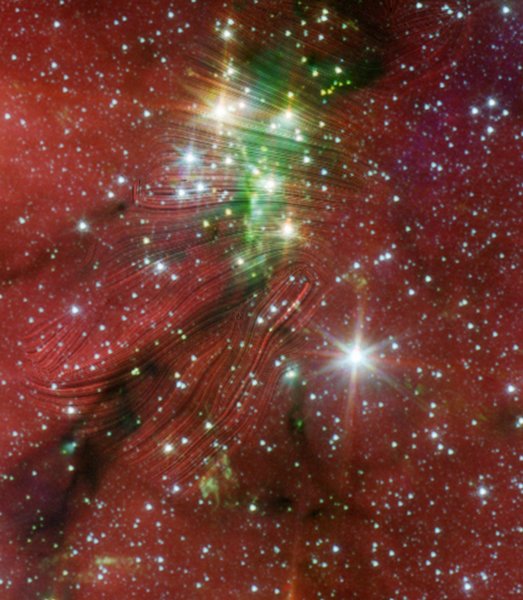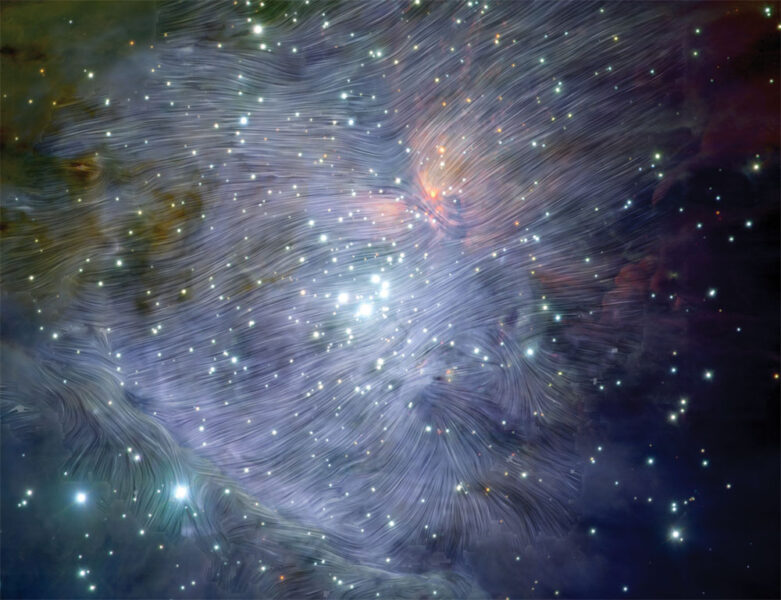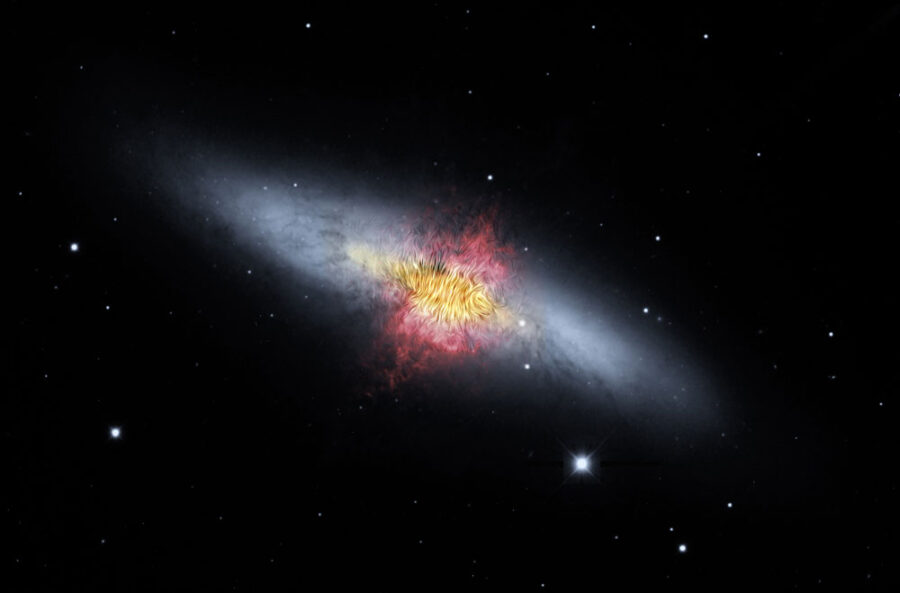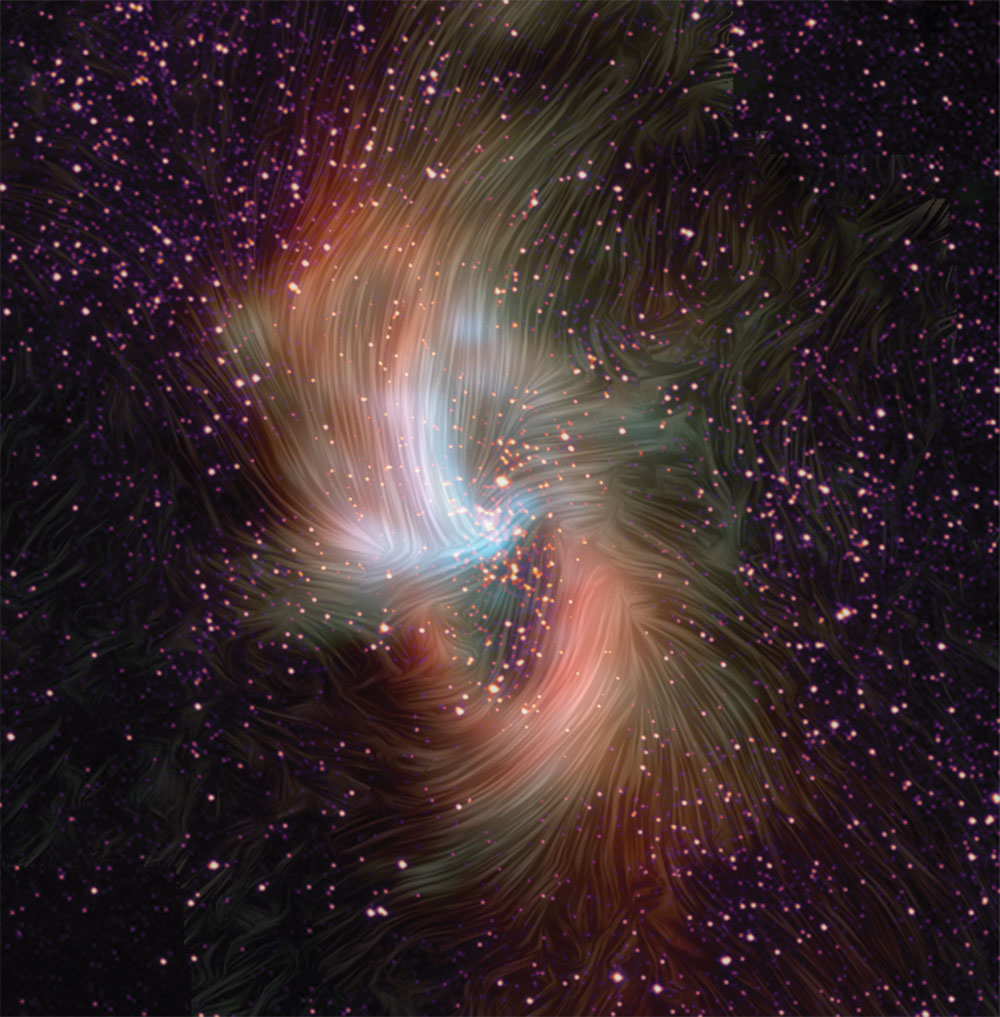Invisible magnetic fields play a role in everything from star formation to galaxy evolution to black hole phenomena. But astronomers still debate what that role is.
The HAWC+ instrument, a far-infrared imager and polarimeter aboard the Stratospheric Observatory for Infrared Astronomy (SOFIA), helped portray magnetism's role in a beautiful way. (SOFIA is now grounded, permanently. See "SOFIA Airborne Observatory Has Taken Its Final Flight" for more details.)
Flying above much of Earth’s atmosphere aboard a modified Boeing 747, HAWC+ measured the polarization of far-infrared radiation, gauging how well the light waves are aligned with each other. Usually, light waves are not aligned with each other at all. But dust grains line up in the space between stars due to interstellar magnetic fields, so the infrared radiation dust emits is polarized. HAWC+ thus enables astronomers to infer the alignment and strength of the magnetic field.

NASA / SOFIA / T. Pillai / J. Kauffmann; NASA / JPL-Caltech / L. Allen
In the August 20th Nature Astronomy, Thushara Pillai (Boston University and Max Planck Institute for Radio Astronomy, Germany) and colleagues used HAWC+ to measure the magnetic fields in a stellar nursery known as Serpens South. Denser filaments permeate such clouds, channeling gas into young star clusters.
Magnetic fields also permeate star-forming clouds — but what they do there remains unclear, as the field strength is 10,000 times weaker than Earth’s magnetic field and therefore difficult to measure.
Previous measurements using the Planck satellite have shown that the magnetic field tends to run parallel to lower-density filaments and perpendicular to higher-density filaments, suggesting that magnetism might moderate star formation by counteracting the pull of gravity.
However, the new HAWC+ measurements taken by Pillai’s team indicate that along the densest, darkest filaments in Serpens South, the magnetic fields once again run parallel. “In some dense filaments the magnetic field succumbs to the flow of matter and is pulled into alignment with the filament,” Pillai explains. In these regions, the weakly magnetized gas is feeding the growth of young stellar clusters like a conveyor belt.
This is only the latest result to come out of HAWC+. A selection of other composite images below visualize the magnetic field lines in the star-forming Orion Nebula, the Cigar Galaxy (M82), and in the region around our galaxy's supermassive black hole.

NASA / SOFIA / D. Chuss / L. Proudfit

NASA / SOFIA / E. Lopez-Rodiguez; NASA / Spitzer / J. Moustakas et al.

NASA / SOFIA / D. Dowell / W. Reach / L Proudfit
The SOFIA 106-inch telescope and instruments image infrared light from on high, flying aboard a modified Boeing 747SP jetliner. Unfortunately, operations have been suspended due to the ongoing COVID-19 pandemic; however, the SOFIA science center remains active and astronomers continue to work with the data that SOFIA has already collected.
 10
10









Comments
stargate
August 25, 2020 at 11:17 am
These images are so beautiful and different from anything else we have seen! Thank you very much for posting this article.
Again your article just underlines the need for astrophysicists and cosmologists to include magnetic fields in their models. Gravity is easy but the real "dark matter" and "dark energy" may be partially explained by the plethora of magnetic fields that permeate our Universe.
You must be logged in to post a comment.
Yaron Sheffer
August 26, 2020 at 10:55 am
So true. It's as if Van Gogh got hold of a few astro pics, and had fun going over them with a brush and some paint, just like he did with Starry Night...
You must be logged in to post a comment.
Sciencesprrings
August 28, 2020 at 4:45 pm
There is no identification of which telescope(s) at Kitt Peak were involved with this image.
I need the name(s) of the telescopes(s). You have my email address.
You must be logged in to post a comment.
Sciencesprrings
August 28, 2020 at 4:51 pm
On the fourth image, the galaxy is not identified and the second instrument on SOFIA is not identified.
I need the name of the galaxy and of the second instrument on SOFIA. You have my email address.
You must be logged in to post a comment.
Andrew James
August 28, 2020 at 8:43 pm
@ Sciencesprrings saying; "You have my email address." & "I need the..."
Monica (and others) here deserves better treatment with a more respectful and conciliatory tone. (It smacks of possible sexism, actually.)
S&T is NOT a 'carriage service' nor should be succeeding to any 'demands' made in such an impolite manner. Such rudeness is unacceptable behaviour by anyone. Desist.
Note: You shown this kind of attitude before. e.g. Saying: "Link to science paper is unclear. Please revise and advise me. You have my email address."
You must be logged in to post a comment.
Monica YoungPost Author
August 31, 2020 at 9:54 am
The galaxy is our own! The fourth image is an image of the Milky Way's galactic center :). You can read more about the image here: https://www.sofia.usra.edu/multimedia/image-galleries/sofia-observations-galactic-center
You must be logged in to post a comment.
Andrew James
August 28, 2020 at 10:10 pm
Some general points;
* Pillai’s team say in their article: "These results indicate that the dust filaments observed by Herschel do not always represent one uniform structure within physical filaments, but perhaps are related filaments along the line of sight that project into the appearance of a single filament. A more robust intensity profile analysis along with further high angular resolution line and continuum observations of more dust filaments in other regions are needed in order to determine if filaments have a common width and the frequency of subfilaments within filaments."
Yet this article says: “In some dense filaments the magnetic field succumbs to the flow of matter and is pulled into alignment with the filament,” Is this an open contradiction?
* An important qualifier is that maser polarisation does't give us direct information on the strength of the magnetic field, which can only be made directly by Zeeman-splitting in spectra.
* Moreover, Earth's field strength is 0.3-0.6 Gauss, while these fields are of few microGauss (or less). Difference is closer to ~100,000 to 500,000 times than 10,000.
* In these images the crossing time (or free-fall time) of about a million of years. e.g. Average projected velocity of field lines between turbulence and aligned field lines (aka magnetised fluid flow). [Anisotropic v isotropic fields]
Note: Ashley Piccone's AAS article here[1] has an excellent summary about the polarimetry / magnetic field connection.
You must be logged in to post a comment.
Andrew James
August 28, 2020 at 10:23 pm
This technical review article by Krumholz & Federrath "The Role of Magnetic Fields in Setting the Star Formation Rate and the Initial Mass Function" (2019) might be of interest to advanced reader. Section 4. Summary and Prospects is an excellent overview.
You must be logged in to post a comment.
Andrew James
August 28, 2020 at 10:59 pm
A further Caltech pdf article is Kronberg: "Extragalactic magnetic fields" (1994), whose introduction is particularly explain the early history of these fields and the difficulty obtaining measurements.
You must be logged in to post a comment.
Monica YoungPost Author
August 31, 2020 at 10:02 am
Hi AJames, So the main conclusion of the article noted in the abstract is: "Here we use far-infrared polarimetric observations from the HAWC+ polarimeter on SOFIA to report the discovery of a further transition in relative orientation, that is, a return to parallel alignment at AV ≳ 21 mag in parts of the Serpens South cloud." Their main conclusion is that the magnetic field is lining up with some of the densest filaments. But of course, more work remains to be done (as ever!) What they mention in the piece that you quote is that some observations of other star-forming regions have shown that what appears to be a single filament is actually multiple braided filaments. So they'll need higher resolution observations to see if that's the case here.
You must be logged in to post a comment.
You must be logged in to post a comment.